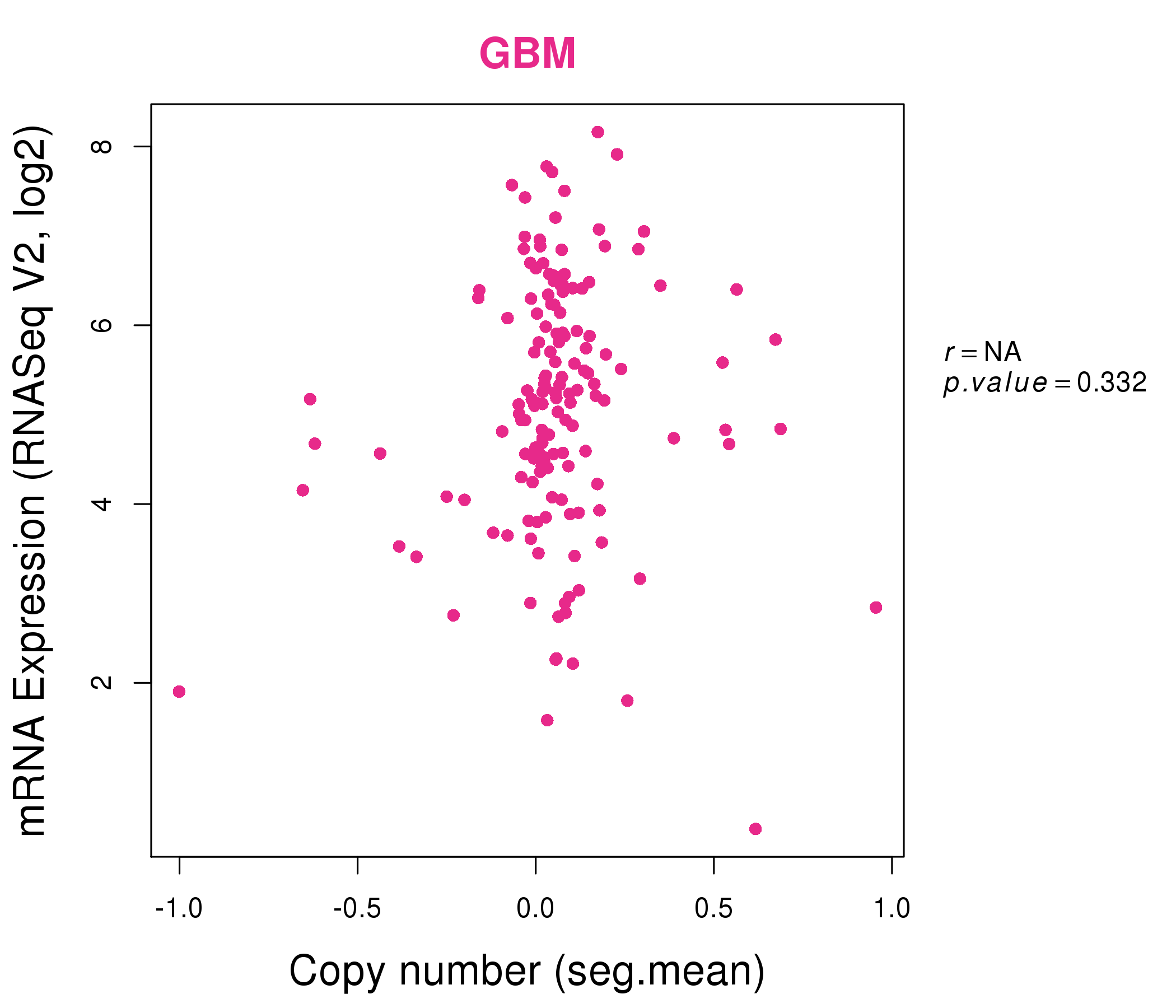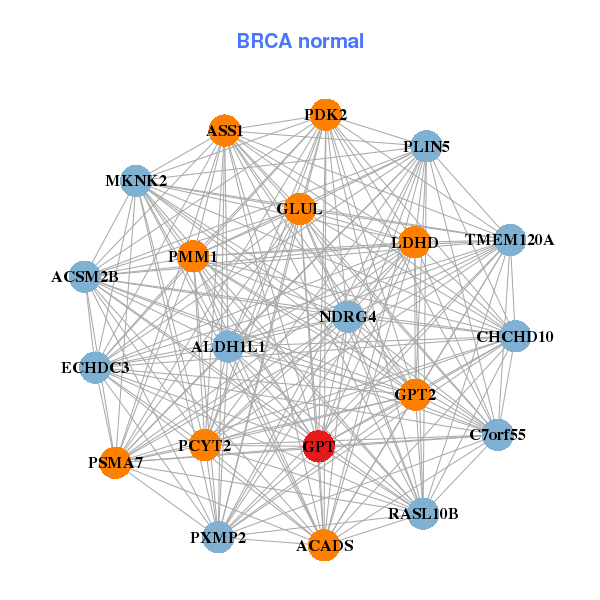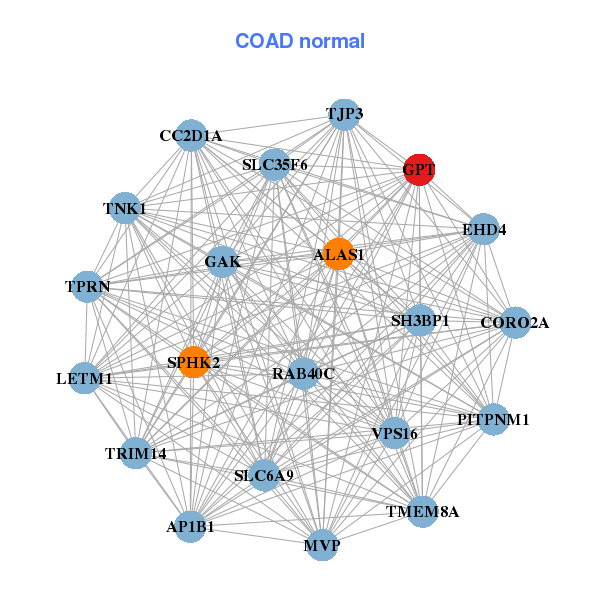|
||||||||||||||||||||
| |
| Phenotypic Information (metabolism pathway, cancer, disease, phenome) |
| |
| |
| Gene-Gene Network Information: Co-Expression Network, Interacting Genes & KEGG |
| |
|
| Gene Summary for GPT |
| Basic gene info. | Gene symbol | GPT |
| Gene name | glutamic-pyruvate transaminase (alanine aminotransferase) | |
| Synonyms | AAT1|ALT1|GPT1 | |
| Cytomap | UCSC genome browser: 8q24.3 | |
| Genomic location | chr8 :145729464-145732555 | |
| Type of gene | protein-coding | |
| RefGenes | NM_005309.2, | |
| Ensembl id | ENSG00000167701 | |
| Description | GPT 1alanine aminotransferase 1glutamate pyruvate transaminase 1glutamic--alanine transaminase 1glutamic--pyruvic transaminase 1glutamic-alanine transaminase 1 | |
| Modification date | 20141218 | |
| dbXrefs | MIM : 138200 | |
| HGNC : HGNC | ||
| Ensembl : ENSG00000167701 | ||
| HPRD : 00689 | ||
| Vega : OTTHUMG00000165176 | ||
| Protein | UniProt: go to UniProt's Cross Reference DB Table | |
| Expression | CleanEX: HS_GPT | |
| BioGPS: 2875 | ||
| Gene Expression Atlas: ENSG00000167701 | ||
| The Human Protein Atlas: ENSG00000167701 | ||
| Pathway | NCI Pathway Interaction Database: GPT | |
| KEGG: GPT | ||
| REACTOME: GPT | ||
| ConsensusPathDB | ||
| Pathway Commons: GPT | ||
| Metabolism | MetaCyc: GPT | |
| HUMANCyc: GPT | ||
| Regulation | Ensembl's Regulation: ENSG00000167701 | |
| miRBase: chr8 :145,729,464-145,732,555 | ||
| TargetScan: NM_005309 | ||
| cisRED: ENSG00000167701 | ||
| Context | iHOP: GPT | |
| cancer metabolism search in PubMed: GPT | ||
| UCL Cancer Institute: GPT | ||
| Assigned class in ccmGDB | C | |
| Top |
| Phenotypic Information for GPT(metabolism pathway, cancer, disease, phenome) |
| Cancer | CGAP: GPT |
| Familial Cancer Database: GPT | |
| * This gene is included in those cancer gene databases. |
|
|
|
|
|
|
| ||||||||||||||
Oncogene 1 | Significant driver gene in | |||||||||||||||||||
| cf) number; DB name 1 Oncogene; http://nar.oxfordjournals.org/content/35/suppl_1/D721.long, 2 Tumor Suppressor gene; https://bioinfo.uth.edu/TSGene/, 3 Cancer Gene Census; http://www.nature.com/nrc/journal/v4/n3/abs/nrc1299.html, 4 CancerGenes; http://nar.oxfordjournals.org/content/35/suppl_1/D721.long, 5 Network of Cancer Gene; http://ncg.kcl.ac.uk/index.php, 1Therapeutic Vulnerabilities in Cancer; http://cbio.mskcc.org/cancergenomics/statius/ |
| KEGG_ALANINE_ASPARTATE_AND_GLUTAMATE_METABOLISM REACTOME_METABOLISM_OF_AMINO_ACIDS_AND_DERIVATIVES | |
| OMIM | |
| Orphanet | |
| Disease | KEGG Disease: GPT |
| MedGen: GPT (Human Medical Genetics with Condition) | |
| ClinVar: GPT | |
| Phenotype | MGI: GPT (International Mouse Phenotyping Consortium) |
| PhenomicDB: GPT | |
| Mutations for GPT |
| * Under tables are showing count per each tissue to give us broad intuition about tissue specific mutation patterns.You can go to the detailed page for each mutation database's web site. |
| There's no structural variation information in COSMIC data for this gene. |
| * From mRNA Sanger sequences, Chitars2.0 arranged chimeric transcripts. This table shows GPT related fusion information. |
| ID | Head Gene | Tail Gene | Accession | Gene_a | qStart_a | qEnd_a | Chromosome_a | tStart_a | tEnd_a | Gene_a | qStart_a | qEnd_a | Chromosome_a | tStart_a | tEnd_a |
| Top |
| There's no copy number variation information in COSMIC data for this gene. |
| Top |
|
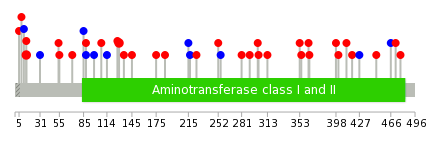 |
| Top |
| Stat. for Non-Synonymous SNVs (# total SNVs=29) | (# total SNVs=5) |
 |  |
(# total SNVs=1) | (# total SNVs=1) |
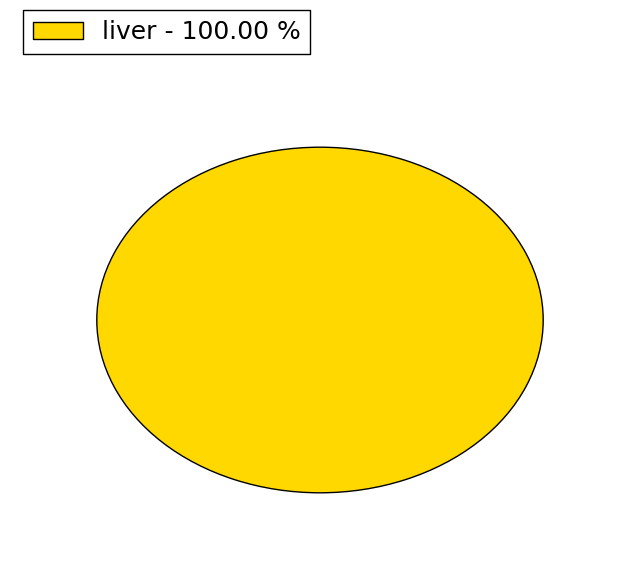 | 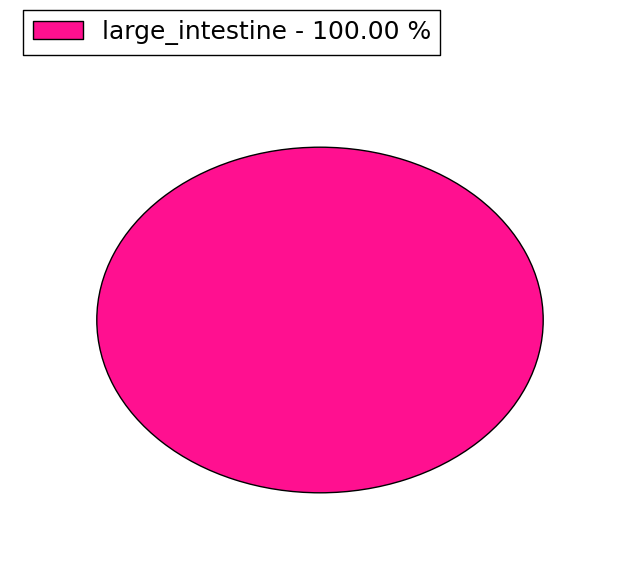 |
| Top |
| * When you move the cursor on each content, you can see more deailed mutation information on the Tooltip. Those are primary_site,primary_histology,mutation(aa),pubmedID. |
| GRCh37 position | Mutation(aa) | Unique sampleID count |
| chr8:145730404-145730404 | p.I129V | 2 |
| chr8:145729727-145729727 | p.H14N | 2 |
| chr8:145729729-145729729 | p.H14Q | 1 |
| chr8:145731945-145731945 | p.N398S | 1 |
| chr8:145730399-145730399 | p.S127C | 1 |
| chr8:145731256-145731256 | p.I255I | 1 |
| chr8:145729780-145729780 | p.R31R | 1 |
| chr8:145731954-145731954 | p.P401H | 1 |
| chr8:145731400-145731400 | p.A281V | 1 |
| chr8:145729849-145729849 | p.Q54H | 1 |
| Top |
|
 |
| Point Mutation/ Tissue ID | 1 | 2 | 3 | 4 | 5 | 6 | 7 | 8 | 9 | 10 | 11 | 12 | 13 | 14 | 15 | 16 | 17 | 18 | 19 | 20 |
| # sample | 3 | 4 | 7 | 1 | 1 | 1 | 1 | 2 | 3 | 3 | 3 | |||||||||
| # mutation | 3 | 4 | 7 | 1 | 1 | 1 | 1 | 2 | 3 | 3 | 3 | |||||||||
| nonsynonymous SNV | 3 | 6 | 1 | 1 | 1 | 2 | 3 | 1 | 2 | |||||||||||
| synonymous SNV | 3 | 1 | 1 | 1 | 2 | 1 |
| cf) Tissue ID; Tissue type (1; BLCA[Bladder Urothelial Carcinoma], 2; BRCA[Breast invasive carcinoma], 3; CESC[Cervical squamous cell carcinoma and endocervical adenocarcinoma], 4; COAD[Colon adenocarcinoma], 5; GBM[Glioblastoma multiforme], 6; Glioma Low Grade, 7; HNSC[Head and Neck squamous cell carcinoma], 8; KICH[Kidney Chromophobe], 9; KIRC[Kidney renal clear cell carcinoma], 10; KIRP[Kidney renal papillary cell carcinoma], 11; LAML[Acute Myeloid Leukemia], 12; LUAD[Lung adenocarcinoma], 13; LUSC[Lung squamous cell carcinoma], 14; OV[Ovarian serous cystadenocarcinoma ], 15; PAAD[Pancreatic adenocarcinoma], 16; PRAD[Prostate adenocarcinoma], 17; SKCM[Skin Cutaneous Melanoma], 18:STAD[Stomach adenocarcinoma], 19:THCA[Thyroid carcinoma], 20:UCEC[Uterine Corpus Endometrial Carcinoma]) |
| Top |
| * We represented just top 10 SNVs. When you move the cursor on each content, you can see more deailed mutation information on the Tooltip. Those are primary_site, primary_histology, mutation(aa), pubmedID. |
| Genomic Position | Mutation(aa) | Unique sampleID count |
| chr8:145732033 | p.V85V | 1 |
| chr8:145730156 | p.Q355H | 1 |
| chr8:145731256 | p.R107G | 1 |
| chr8:145732168 | p.N398S | 1 |
| chr8:145730220 | p.A114A | 1 |
| chr8:145731400 | p.P401H | 1 |
| chr8:145732224 | p.S127C | 1 |
| chr8:145730243 | p.A411V | 1 |
| chr8:145731402 | p.D135E | 1 |
| chr8:145732325 | p.V418M | 1 |
| * Copy number data were extracted from TCGA using R package TCGA-Assembler. The URLs of all public data files on TCGA DCC data server were gathered on Jan-05-2015. Function ProcessCNAData in TCGA-Assembler package was used to obtain gene-level copy number value which is calculated as the average copy number of the genomic region of a gene. |
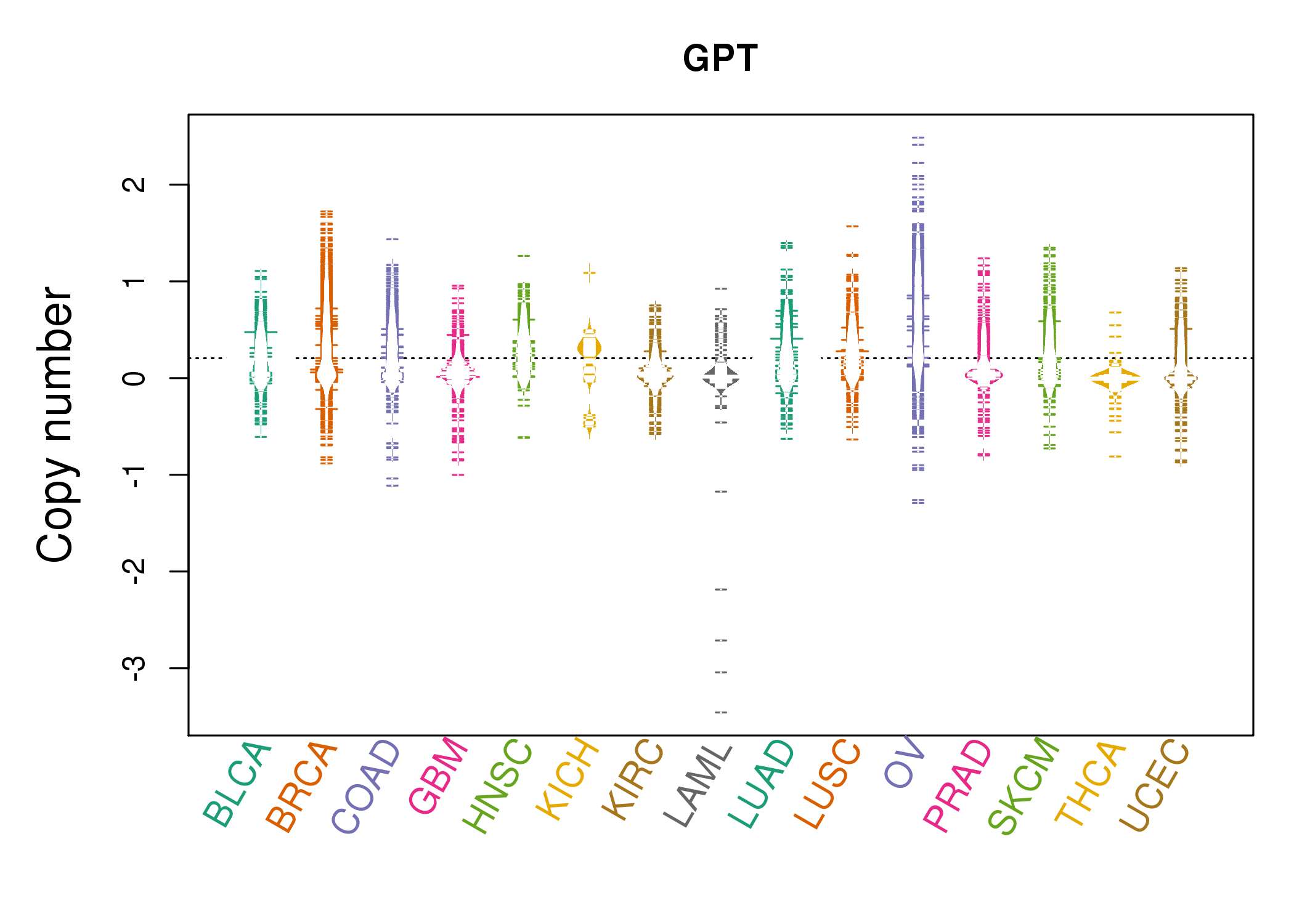 |
| cf) Tissue ID[Tissue type]: BLCA[Bladder Urothelial Carcinoma], BRCA[Breast invasive carcinoma], CESC[Cervical squamous cell carcinoma and endocervical adenocarcinoma], COAD[Colon adenocarcinoma], GBM[Glioblastoma multiforme], Glioma Low Grade, HNSC[Head and Neck squamous cell carcinoma], KICH[Kidney Chromophobe], KIRC[Kidney renal clear cell carcinoma], KIRP[Kidney renal papillary cell carcinoma], LAML[Acute Myeloid Leukemia], LUAD[Lung adenocarcinoma], LUSC[Lung squamous cell carcinoma], OV[Ovarian serous cystadenocarcinoma ], PAAD[Pancreatic adenocarcinoma], PRAD[Prostate adenocarcinoma], SKCM[Skin Cutaneous Melanoma], STAD[Stomach adenocarcinoma], THCA[Thyroid carcinoma], UCEC[Uterine Corpus Endometrial Carcinoma] |
| Top |
| Gene Expression for GPT |
| * CCLE gene expression data were extracted from CCLE_Expression_Entrez_2012-10-18.res: Gene-centric RMA-normalized mRNA expression data. |
 |
| * Normalized gene expression data of RNASeqV2 was extracted from TCGA using R package TCGA-Assembler. The URLs of all public data files on TCGA DCC data server were gathered at Jan-05-2015. Only eight cancer types have enough normal control samples for differential expression analysis. (t test, adjusted p<0.05 (using Benjamini-Hochberg FDR)) |
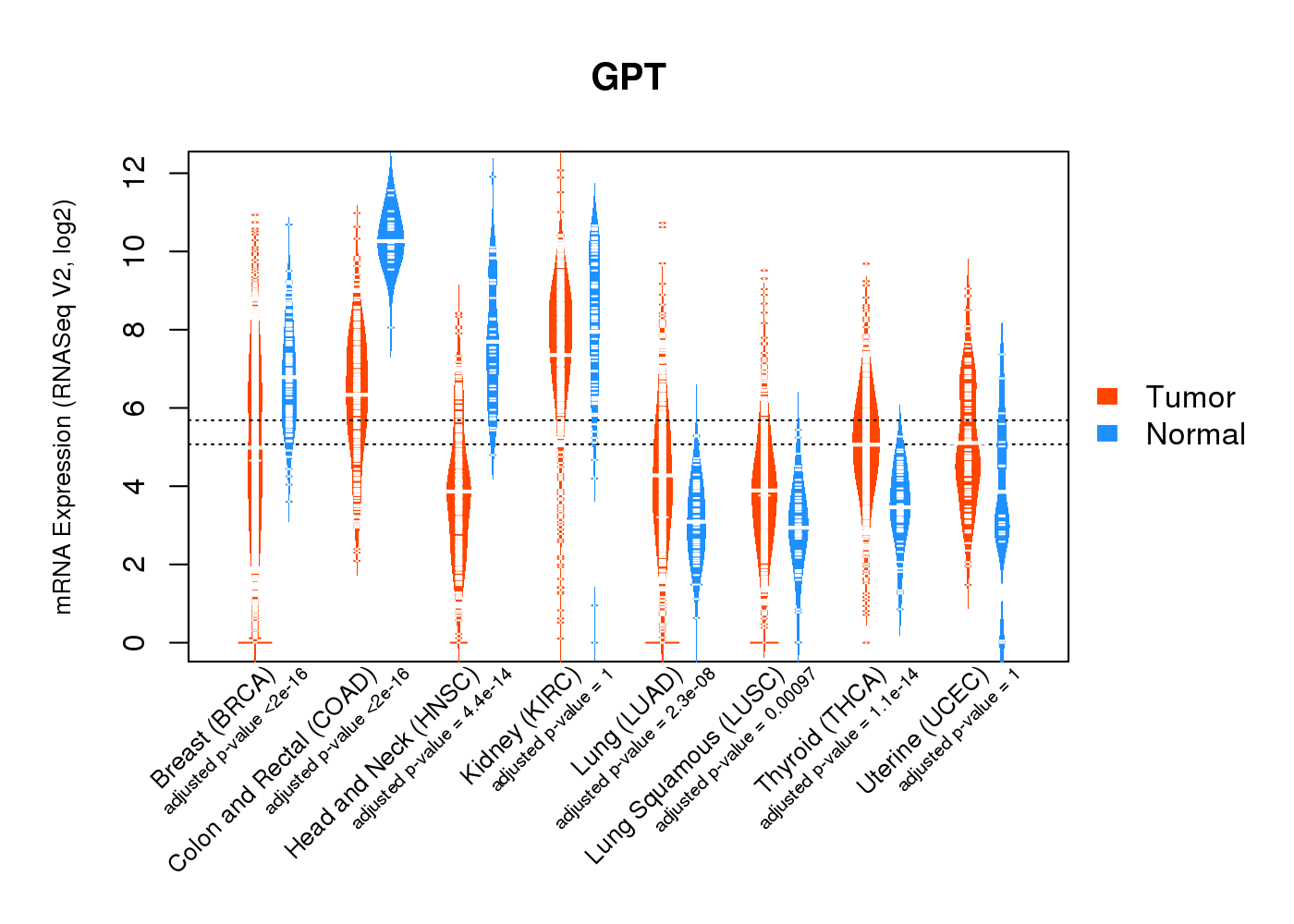 |
| Top |
| * This plots show the correlation between CNV and gene expression. |
: Open all plots for all cancer types
 |
|
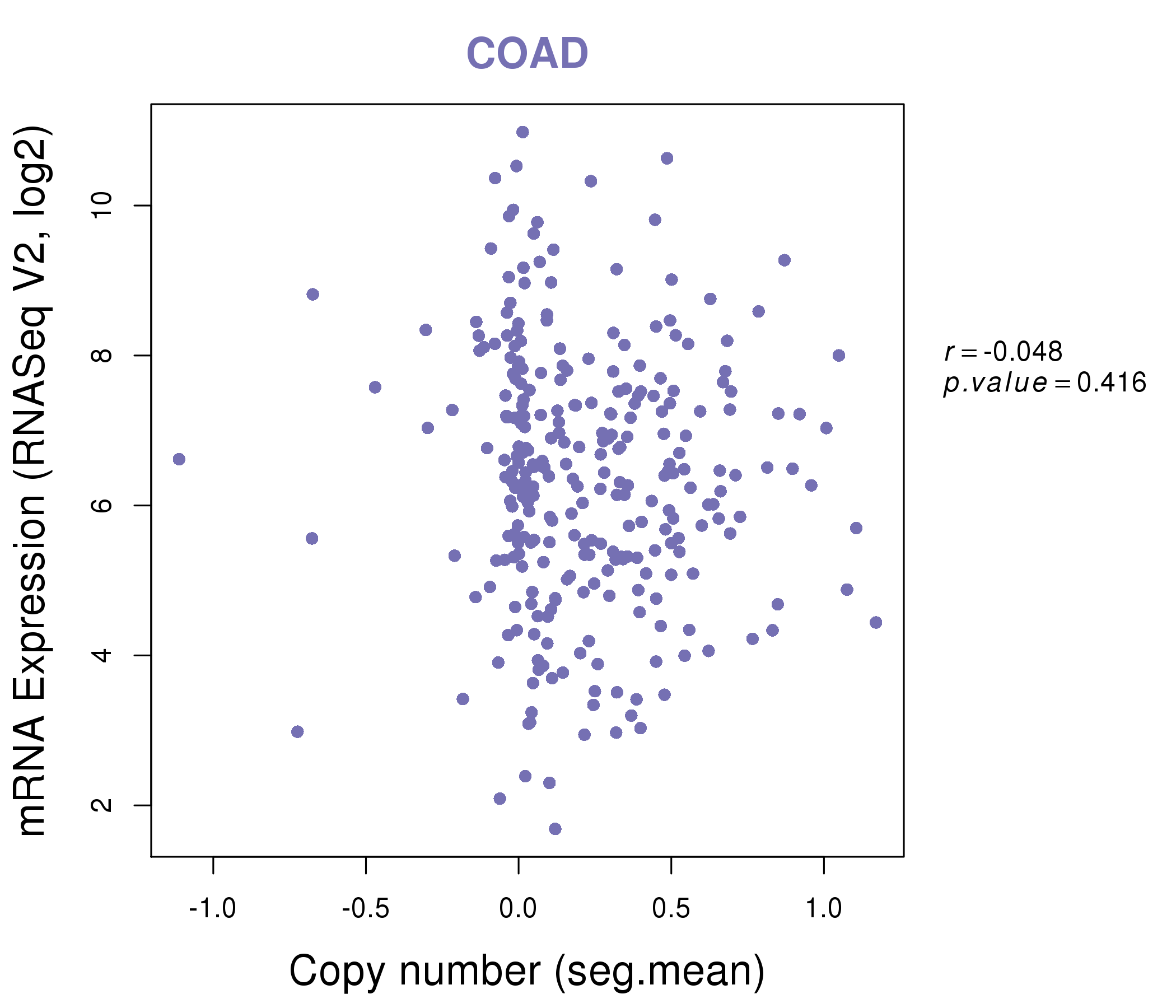 |
|
| Top |
| Gene-Gene Network Information |
| * Co-Expression network figures were drawn using R package igraph. Only the top 20 genes with the highest correlations were shown. Red circle: input gene, orange circle: cell metabolism gene, sky circle: other gene |
: Open all plots for all cancer types
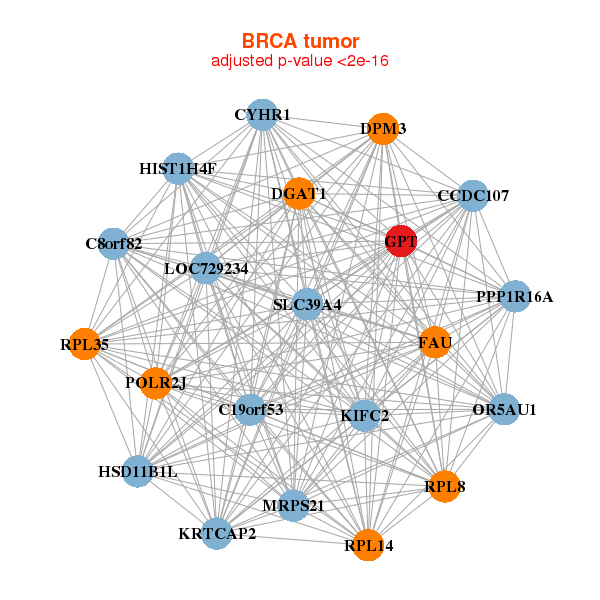 |
| ||||
| ASNS,CMC2,CFAP20,C16orf87,AUNIP,CDCA8,EMC8, GPT2,KARS,TLDC1,NAE1,NIP7,NUP93,ORC6, PAK1IP1,PSAT1,RANBP1,RBM17,RGMA,SHCBP1,SNRPD1 | ACAT1,ADHFE1,CS,DLD,DLST,ETFA,ETFDH, GPT2,HSPB6,KIAA0408,NDUFV3,PDHA1,PDK2,GATB, PFKFB1,PGM1,PHYH,PLIN5,RNF157,SLC2A4,SLC6A8 | ||||
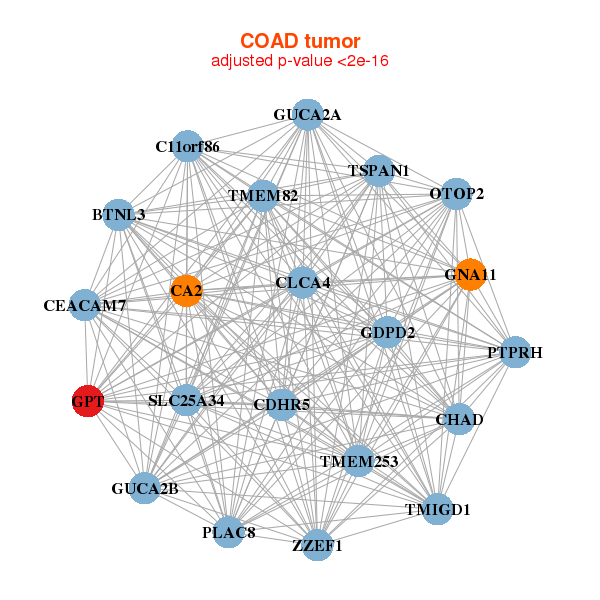 |
| ||||
| AARS,SAPCD2,CCDC86,GARS,GFPT1,GGCT,GOT2, GPT2,HNRNPAB,LONP1,ORC6,PDF,PGP,PHGDH, PKMYT1,PSAT1,SAC3D1,SLC19A1,SLC29A2,STC2,ZNF598 | ANLN,AURKA,CCNB1,CDC20,CDCA8,CENPA,CENPO, CEP55,CLDN14,GPT2,GSDMB,KIF18A,KPNA2,MUC1, MYEOV,NFE2L3,PDIA4,PLK1,POC1A,PSAT1,TMEM214 |
| * Co-Expression network figures were drawn using R package igraph. Only the top 20 genes with the highest correlations were shown. Red circle: input gene, orange circle: cell metabolism gene, sky circle: other gene |
: Open all plots for all cancer types
| Top |
: Open all interacting genes' information including KEGG pathway for all interacting genes from DAVID
| Top |
| Pharmacological Information for GPT |
| DB Category | DB Name | DB's ID and Url link |
| * Gene Centered Interaction Network. |
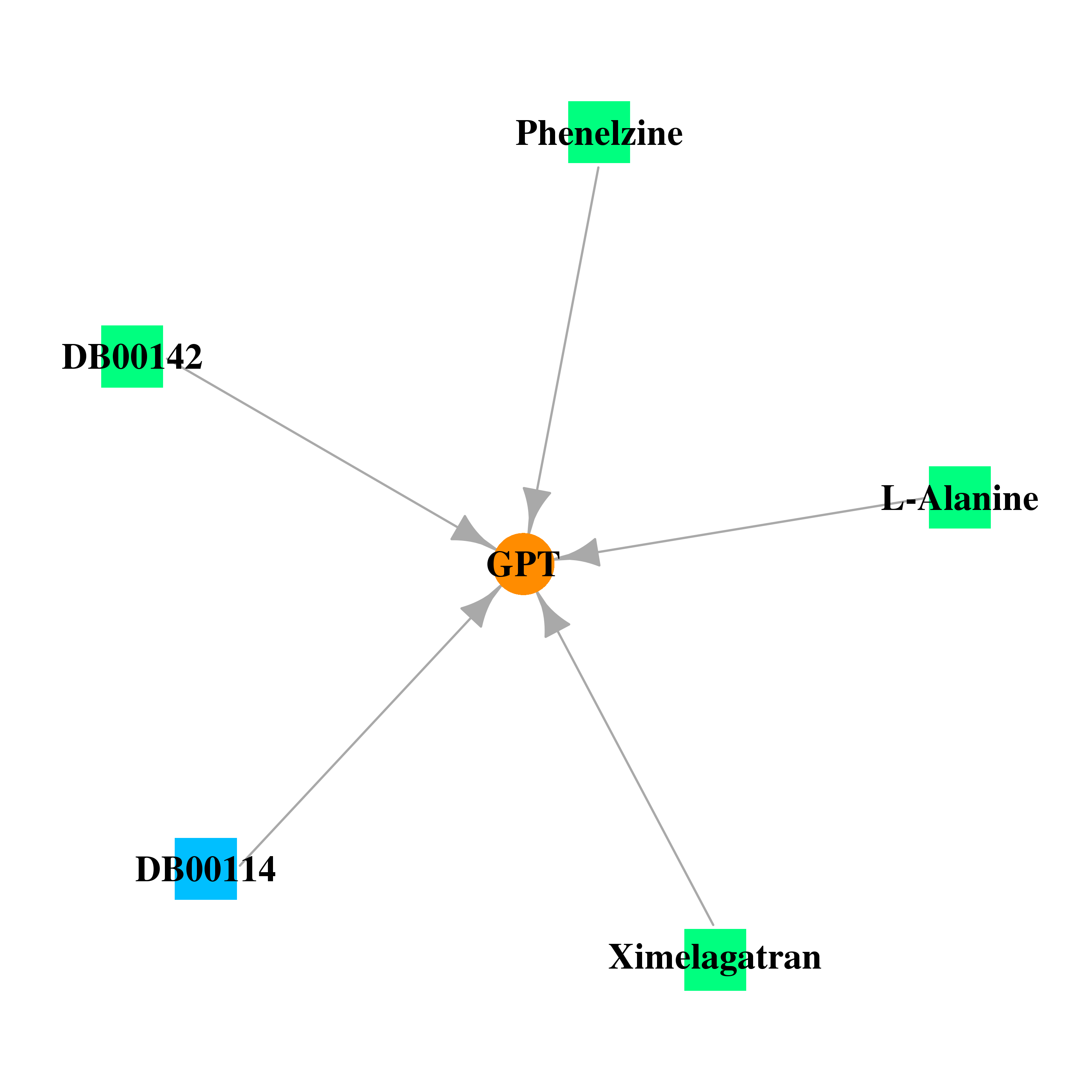 |
| * Drug Centered Interaction Network. |
| DrugBank ID | Target Name | Drug Groups | Generic Name | Drug Centered Network | Drug Structure |
| DB00114 | glutamic-pyruvate transaminase (alanine aminotransferase) | nutraceutical | Pyridoxal Phosphate | 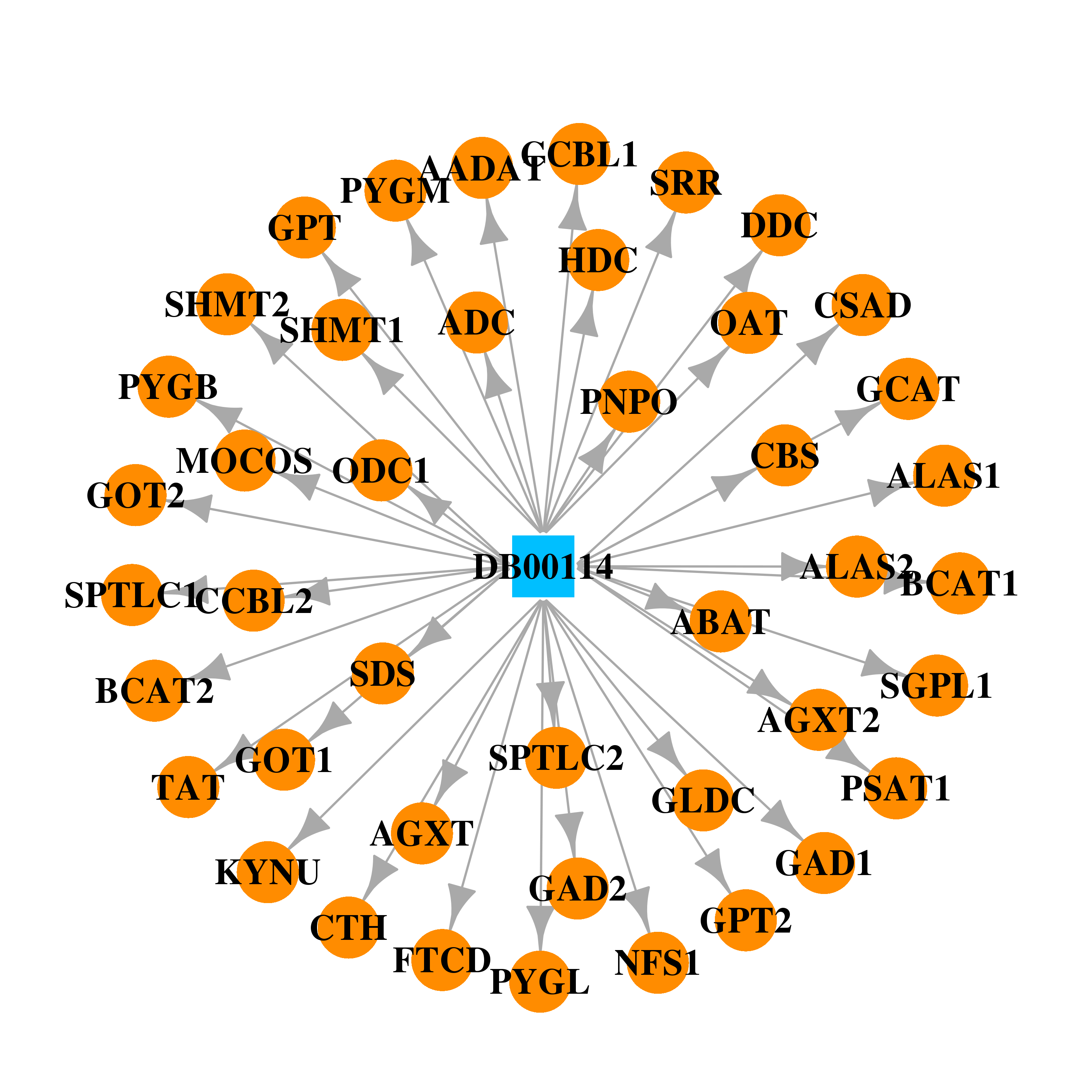 | 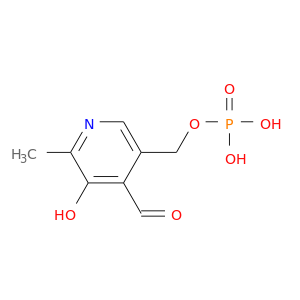 |
| DB00142 | glutamic-pyruvate transaminase (alanine aminotransferase) | approved; nutraceutical | L-Glutamic Acid | 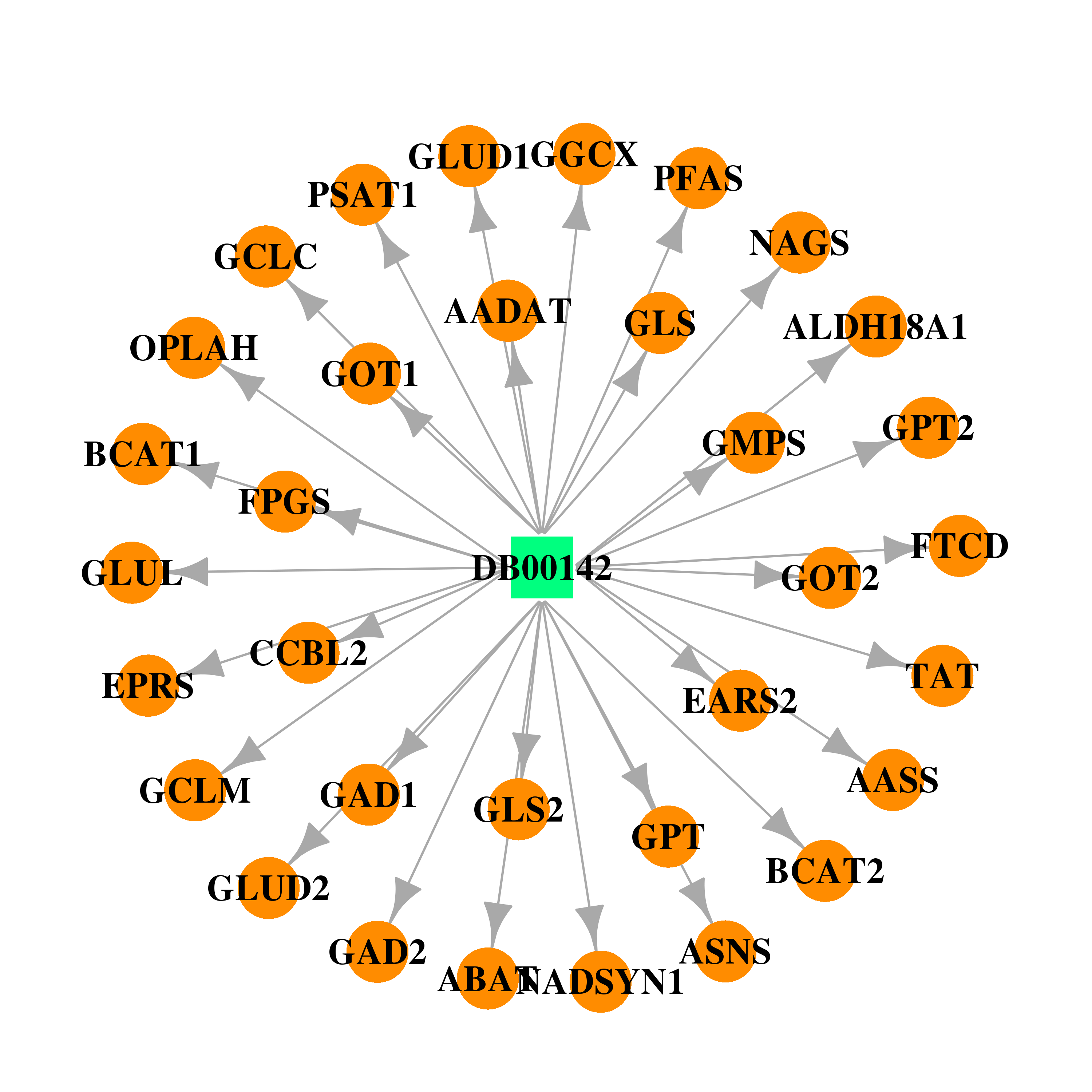 | 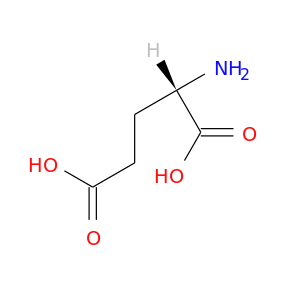 |
| DB00160 | glutamic-pyruvate transaminase (alanine aminotransferase) | approved; nutraceutical | L-Alanine |  | 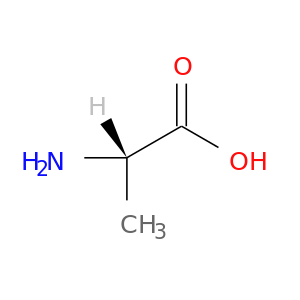 |
| DB00780 | glutamic-pyruvate transaminase (alanine aminotransferase) | approved | Phenelzine |  | 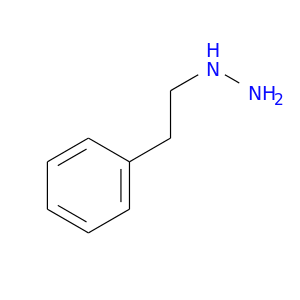 |
| DB04898 | glutamic-pyruvate transaminase (alanine aminotransferase) | approved; withdrawn; investigational | Ximelagatran | 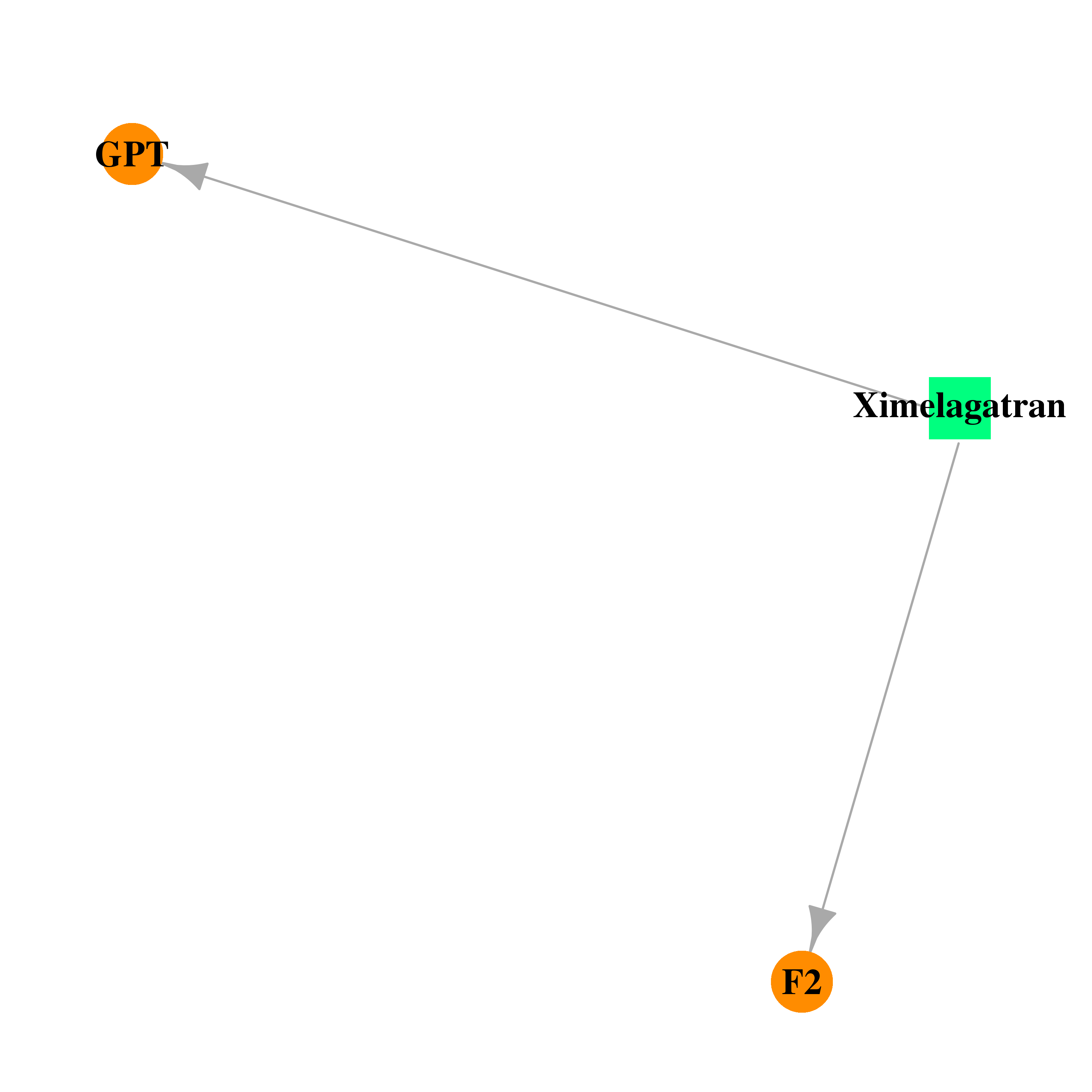 |  |
| Top |
| Cross referenced IDs for GPT |
| * We obtained these cross-references from Uniprot database. It covers 150 different DBs, 18 categories. http://www.uniprot.org/help/cross_references_section |
: Open all cross reference information
|
Copyright © 2016-Present - The Univsersity of Texas Health Science Center at Houston @ |







